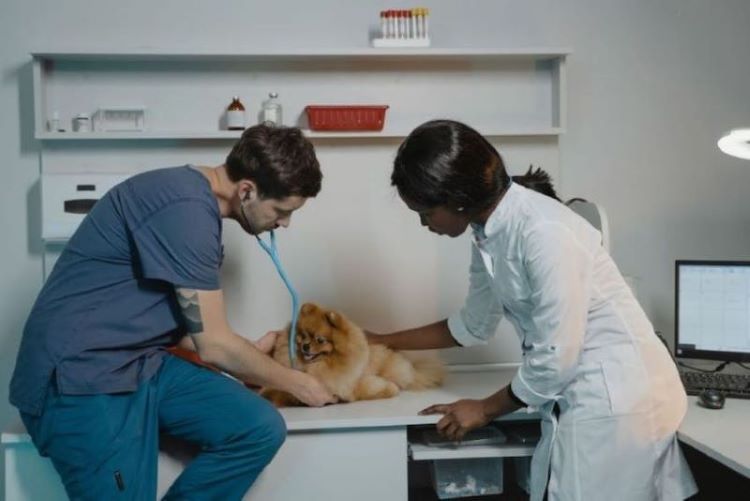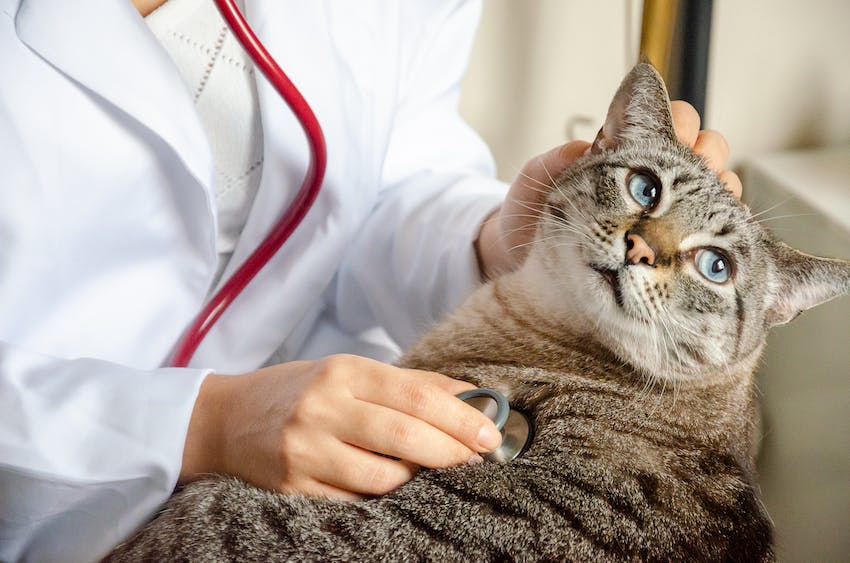Ready to help treat your pet to a healthy life?
Your Pet’s Health Care Team: Veterinary Jobs and What They Do
By : Brianna Gunter | Published Jun 4, 2024

When your dog or cat has a veterinary appointment, they don’t just see their veterinarian. Their veterinary visits often involve a few different people, whether conducting a routine checkup or diagnosing new symptoms. But do you know what all of their job titles are or the specific role they play in your pet’s health?
Whether you’re interested in working in the veterinary field yourself or just want to be more informed on the team taking care of your pet, this quick guide to different veterinary jobs has you covered.
6 common veterinary staff positions to know
Veterinary teams can vary greatly, depending on how large the clinic is and what kinds of services they provide. At smaller practices, the responsibilities typically assigned to different roles within the veterinary world are more likely to overlap — many veterinary professionals today wear multiple hats. Hospitals offering emergency and/or other specialty care may likewise have larger staffs with more diverse areas of responsibility.
Location also matters when it comes to veterinary roles. For example, different states and countries have their own rules on the specific tasks veterinary technicians and assistants can perform with and without supervision from a licensed veterinarian. This means a veterinary clinic in one state may require additional team members — or have different staff roles — than a clinic performing similar services in another state.
Veterinary job titles may change accordingly from practice to practice, especially among private practices. After all, independent businesses may have their own way of operating vs. larger veterinary organizations that follow more rigid corporate guides.
Of course, the veterinary workers you come into personal contact with depends on both your local clinic and your pet’s individual health needs. Nevertheless, these are the different kinds of job roles you may commonly run into at animal hospitals.
1. Veterinarian
A veterinarian (often just called a “vet”) is a medical doctor for animals. They hold a Doctorate of Veterinary Medicine and are sometimes called a “DVM” as a result. Their primary role is to diagnose, treat, and prevent illnesses and injuries in pets like dogs and cats, though many veterinarians specialize in treating other animals as well. Day-to-day tasks can vary greatly for vets, and they may include any of the following:
- Performing physical exams
- Administering vaccinations
- Diagnosing illnesses and prescribing appropriate medications
- Performing surgeries, including pre- and post-operative monitoring and care
- Interpreting diagnostic tests (blood work, X-rays, ultrasounds, etc.)
- Advising pet owners on proper care, behavior, and preventive health measures
Depending on the size of the practice and how busy it is, veterinarians may also perform a wide range of additional roles, including clerical and janitorial work. In order to continue practicing, veterinarians must register where they are located and may have to renew their license on a routine basis.
Looking to thank your pet’s vet for all that they do? June 18 is Veterinary Appreciation Day!

2. Veterinary technician / Veterinary nurse
In many ways, veterinary technicians or “vet techs” are the backbone of modern veterinary practices. Also referred to as “veterinary nurses,” these are trained professionals who assist veterinarians in providing medical care to animals. Their duties include a wide range of clinical tasks: drawing blood, taking X-rays and performing other lab tests, administering medications, preparing animals for surgery, and even just keeping animal patients calm and comfortable. The exact tasks a vet tech performs depends largely on their certifications and licensing — in areas where registration is required, veterinary technicians must continue to meet education standards and renew their license annually or every few years.
Vet techs also play a critical role in communicating with pet owners, answering questions and sharing proper animal care and post-treatment procedures. They may also assist in other aspects of running the practice wherever they are needed.
3. Veterinary assistant
Veterinary assistants provide crucial support to veterinarians and veterinary technicians. Their responsibilities are focused on ensuring the smooth operation of a veterinary clinic and can include anything from helping handle animals during examinations and procedures, cleaning and sterilizing equipment, feeding and exercising patients, soothing and petting them when needed, and maintaining clean and organized work areas.
While their roles may appear highly similar to veterinary technicians, veterinary assistants typically receive on-the-job training and do not require formal certification, though some may complete specialized training programs. Depending on the clinic’s needs, veterinary assistants may also perform administrative work and help run the reception desk (see below).
4. Receptionist
A veterinary practice receptionist serves as the first point of contact for pet owners and animal patients, and as such are often the face of the clinic. Their duties are largely administrative and include scheduling appointments, managing phone calls, greeting clients, maintaining patient records, handling client billing and payments, and even communicating with pet insurance providers. They may also conduct patient intake and be trained to handle pet health questions upfront, such as during potential emergency situations. To put it simply, veterinary receptionists are key to ensuring the practice runs smoothly and can help as many pets daily as possible.
5. Practice manager
Although you may not come into direct contact with your local veterinary practice manager during your pal’s appointments, they perform a crucial role in your furry friend’s health and well-being. This individual is in charge of all administrative and business aspects of a clinic or animal hospital, overseeing finances (including business accounting and staff payroll), facility operations, and compliance with local and national veterinary regulations. They also typically oversee human resources tasks, which means they’re the person you can thank for hiring and supervising your favorite veterinary staff.
6. Veterinary medical director
Just as the practice manager oversees the business side of things, the veterinary medical director oversees the medical operations of a practice. They’re the lead veterinarian on staff, responsible for ensuring clinical operations meet high-quality medical standards and regulations. They set protocols, supervise veterinarians (and sometimes vet techs), conduct reviews, and often serve as mentors. They may also take the lead on particularly complex medical cases to ensure pets get the best care possible. The medical director may also collaborate with the practice manager for the clinic’s long-term goals and growth.

Other positions in the veterinary field
Veterinary practices vary greatly in size and services. On top of this, the veterinary world is a lot bigger than just what you see during your pet’s routine health appointments. Other important roles in the veterinary field include (but may not be limited to) the following:
- Veterinary specialist — a veterinarian with advanced training and certification in a specific area of veterinary medicine: surgery, dermatology, cardiology, oncology, etc. They may sometimes be referred to by their specialization, i.e. “veterinary oncologist.”
- Veterinary intern — a recent veterinary school graduate undergoing advanced, supervised training in a clinical setting. This training prepares them for future specialization or independent practice in veterinary medicine.
- Veterinary resident — a DVM who has typically completed an internship and has decided to go on to train to be a veterinary specialist but is not yet board-certified.
- Animal caretaker — also sometimes referred to as a “kennel assistant,” this is designated person at a veterinary hospital who feeds, cleans, and provides basic care for animal patients, ensuring their well-being and comfort before and after medical treatments (like surgeries).
- Janitorial staff — a staff member responsible for cleaning the facility and ensuring it meets strict hygiene standards.
- Veterinary researchers — a scientific researcher (and often a trained veterinarian) who conducts scientific studies to improve animal health, develop treatments, and enhance veterinary medical practices. Though not typically a part of a veterinary practice team, they are crucial to the treatments available to your pet.
- Pet insurance claims specialists — an individual who processes pet medical insurance claims and reviews documentation, often communicating directly with animal hospitals and clinics. They are an important part of the veterinary world to help ensure streamlined care for protected pets and are sometimes experienced veterinarians and vet techs themselves.
Get the most out of your pet’s veterinary care
No matter how big or small your furry friend’s healthcare team is, it’s important to keep up with routine checkups and preventive health measures (like parasite prevention). Though since you never know what may come your pet’s way, it’s also a good idea to sign up for pet health insurance. A good plan helps ensure your pet will be able to get the veterinary care they need for surprise illnesses, injuries, and accidents. With this in place along with better understanding of your pet’s veterinary team, you can spend less time worrying and more time focused on helping your pal get well.
